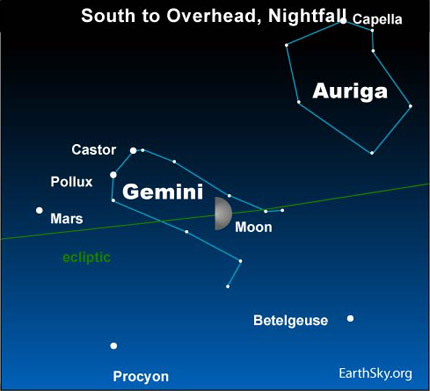Courtesy of EarthSky
A Clear Voice for Science
www.EarthSky.org
Tonight, the waxing gibbous moon shines in front of the constellation Gemini, and is flanked by two beautiful stars. To the north of the moon is Capella, the beacon star in the constellation Auriga the Charioteer. To the moon’s south you will find Procyon, the brightest light in the constellation Canis Minor the Little Dog.
When you look at the moon at the same time each day, the moon appears to be farther east of where it stood the day before. Yesterday, for instance, the moon shone between the stars Capella and Betelgeuse. On the average, the moon moves 13 degrees eastward daily in front of the background stars. (Your fist at an arm length approximates 10 degrees of sky.)
The moon’s change of position relative to the stars is a true measure of the distance covered by the moon in its eastward orbit around Earth. You’ll always find the moon and planets on or near the ecliptic – the Earth’s orbital plane projected outward onto the sphere of stars.
Tomorrow, the moon will hop close to the planet Mars. You’ll see the Gemini star Castor to the north of the moon, and the Little Dog star Procyon to the south of the moon. By the way, a line drawn from Procyon and passing in between the Gemini stars Castor and Pollux always points north, toward Polaris the North Star.
Written by Bruce McClure
Other Links:
Astronomy Picture of the Day from NASA/JPL
